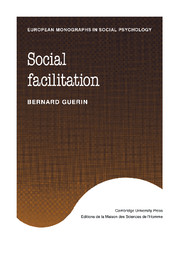Book contents
- Frontmatter
- Contents
- Acknowledgements
- 1 Introduction
- I The history and development of social facilitation research
- II Theories of social facilitation
- III Experimental studies of social facilitation
- 7 Social facilitation effects in animals
- 8 Social facilitation effects in humans
- IV The place of social facilitation in social psychology
- References
- Author index
- Subject index
8 - Social facilitation effects in humans
Published online by Cambridge University Press: 15 January 2010
- Frontmatter
- Contents
- Acknowledgements
- 1 Introduction
- I The history and development of social facilitation research
- II Theories of social facilitation
- III Experimental studies of social facilitation
- 7 Social facilitation effects in animals
- 8 Social facilitation effects in humans
- IV The place of social facilitation in social psychology
- References
- Author index
- Subject index
Summary
Mere presence effects in humans
Introduction
The large number of theories of social facilitation were reviewed in Chapters 4, 5, and 6. It was suggested there that although most theories have been supported by some experimental evidence, the evidence presented has usually been consistent with other theories as well. To ignore this in a review leads to misinterpretations.
More than this, the many poorly designed studies need to be separated from the more carefully controlled ones. This is especially important with the subtle conditions necessary for tests of mere presence. As was pointed out in Chapter 2, many studies have had the experimenter present in the ‘Alone’ Condition; to include these in the total review would be to blur the better studies.
The present chapter reviews the experimental literature on mere presence and other social facilitation effects. To do this, a situation-specific analysis was made of the literature. That is, each study was ‘taxonomically’ analysed according to a number of criteria which categorized the situation of the experiment. Each was then examined to see what effects, if any, were found. To carry this out, criteria were needed to define what will be meant by a well-controlled mere presence study and a poorly controlled one. This has not been made explicit before in the literature. The criteria which were formulated will be outlined below.
This way of reviewing the literature differs from traditional reviews which add up the number of studies finding a particular effect, those finding the opposite effect, and those finding no effect (Glaser, 1982; Kushnir, 1981).
- Type
- Chapter
- Information
- Social Facilitation , pp. 128 - 156Publisher: Cambridge University PressPrint publication year: 1993



